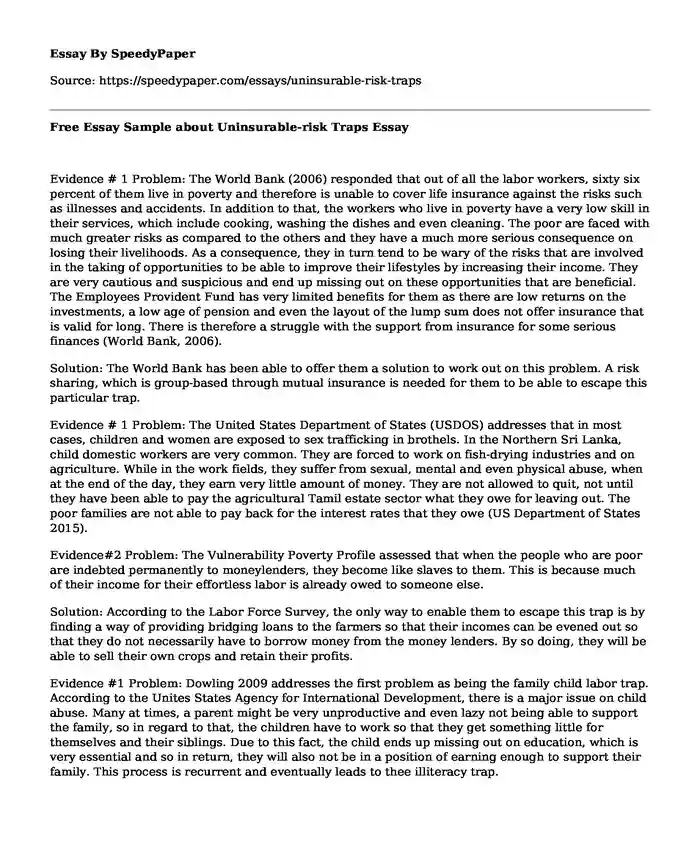Evidence # 1 Problem: The World Bank (2006) responded that out of all the labor workers, sixty six percent of them live in poverty and therefore is unable to cover life insurance against the risks such as illnesses and accidents. In addition to that, the workers who live in poverty have a very low skill in their services, which include cooking, washing the dishes and even cleaning. The poor are faced with much greater risks as compared to the others and they have a much more serious consequence on losing their livelihoods. As a consequence, they in turn tend to be wary of the risks that are involved in the taking of opportunities to be able to improve their lifestyles by increasing their income. They are very cautious and suspicious and end up missing out on these opportunities that are beneficial. The Employees Provident Fund has very limited benefits for them as there are low returns on the investments, a low age of pension and even the layout of the lump sum does not offer insurance that is valid for long. There is therefore a struggle with the support from insurance for some serious finances (World Bank, 2006).
Solution: The World Bank has been able to offer them a solution to work out on this problem. A risk sharing, which is group-based through mutual insurance is needed for them to be able to escape this particular trap.
Evidence # 1 Problem: The United States Department of States (USDOS) addresses that in most cases, children and women are exposed to sex trafficking in brothels. In the Northern Sri Lanka, child domestic workers are very common. They are forced to work on fish-drying industries and on agriculture. While in the work fields, they suffer from sexual, mental and even physical abuse, when at the end of the day, they earn very little amount of money. They are not allowed to quit, not until they have been able to pay the agricultural Tamil estate sector what they owe for leaving out. The poor families are not able to pay back for the interest rates that they owe (US Department of States 2015).
Evidence#2 Problem: The Vulnerability Poverty Profile assessed that when the people who are poor are indebted permanently to moneylenders, they become like slaves to them. This is because much of their income for their effortless labor is already owed to someone else.
Solution: According to the Labor Force Survey, the only way to enable them to escape this trap is by finding a way of providing bridging loans to the farmers so that their incomes can be evened out so that they do not necessarily have to borrow money from the money lenders. By so doing, they will be able to sell their own crops and retain their profits.
Evidence #1 Problem: Dowling 2009 addresses the first problem as being the family child labor trap. According to the Unites States Agency for International Development, there is a major issue on child abuse. Many at times, a parent might be very unproductive and even lazy not being able to support the family, so in regard to that, the children have to work so that they get something little for themselves and their siblings. Due to this fact, the child ends up missing out on education, which is very essential and so in return, they will also not be in a position of earning enough to support their family. This process is recurrent and eventually leads to thee illiteracy trap.
Solution: The effective solution which the American States Agency for International Development is by finding a way by which the incomes of the families are raised, and with more emphasis on those of the mothers, in particular, so that they may afford a better lifestyle and send their children to school. This will eventually improve the living standards of those affected by intense poverty (Dowling, 2009).
Evidence #1 Problem: According to the Sri Lanka Business Development Corporation, there is the presence of the working capital trap which is associated with the lack of credit which stops business people who are small from being able to expand on their businesses. Farmers are also affected as they are limited from the diversification of their products. The capital in this instance is a very huge trap as it limits even the people with potential at the grass root levels from rising as some of them do not know where to start from.
Solution: The World Bank, in this contest stated that there was a need for the micro-credit schemes to be provided and updated in order to enable the people living in poverty in Sri-Lanka evade this trap. For the ones that are extremely poor with non-collaterals, schemes that are group-based could share the risks and even give assurance to the lender that the loans offered to them are viable (Asia Development Bank, 2006).
Asian Development Bank. (1996). Escaping the Poverty Trap: Lessons from Asia. Manila: Asian Development Bank.
Dowling, J. M., & Yap, C.-F. (2009). Chronic poverty in Asia: Causes, consequences and policies. Singapore: World Scientific.
US Department of State (2015) Sri Lanka
World Bank Internet (2006). Strengthening Social Protection.
Cite this page
Free Essay Sample about Uninsurable-risk Traps. (2019, Jul 19). Retrieved from https://speedypaper.com/essays/uninsurable-risk-traps
Request Removal
If you are the original author of this essay and no longer wish to have it published on the SpeedyPaper website, please click below to request its removal:
- Free Essay on the Role of Spirituality in Healing and Healthcare
- Free Essay Sample on Organization Efficiency
- Essay Example: Renal Case Study
- Essay Example: Psychological and Sociological Explanations of Deviant Behavior
- Free Essay Focusing on the Cost of Loving Others
- Essay Sample on Professional Soccer in the United States
- Paper Example. Technology on Loneliness
Popular categories





